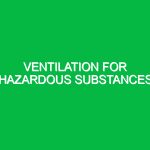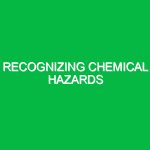Introduction to Hazard Communication Programs
Hazard communication programs serve as a critical framework within the Health, Safety, and Environment (HSE) domain, designed to ensure that everyone in the workplace understands the risks associated with hazardous substances. At its core, a hazard communication program is about the effective communication of information regarding chemical hazards to employees, customers, and emergency responders. This ensures that individuals are not only aware of the potential dangers but are also equipped with the knowledge to handle them safely.
The relevance of hazard communication programs cannot be overstated. In industries where chemicals are prevalent—such as manufacturing, construction, and healthcare—these programs play a vital role in preventing accidents, injuries, and fatalities. When implemented correctly, they foster a safety culture that prioritizes health and well-being, leading to more productive workplaces.
Identifying Hazards and Risks
In any hazard communication program, the first step is identifying potential hazards associated with the chemicals in use. The Occupational Safety and Health Administration (OSHA) defines a hazardous chemical as any chemical that poses a physical or health hazard. This includes substances that are combustible, toxic, corrosive, or reactive.
Let’s consider an example from the manufacturing sector: a factory that uses solvents for painting. The solvents can emit harmful vapors, leading to respiratory issues. Furthermore, if not stored properly, they pose fire risks. Identifying these hazards is crucial. It involves not just recognizing the chemicals themselves but also understanding the conditions under which they become dangerous.
Hazards can be categorized into two main types: health hazards and physical hazards. Health hazards include carcinogens, irritants, and sensitizers, while physical hazards encompass flammables, explosives, and compressed gases. A comprehensive hazard communication program requires a thorough analysis of these risks, often involving Material Safety Data Sheets (MSDS) or Safety Data Sheets (SDS) that provide critical information about each substance.
Safety Precautions and Best Practices
Once hazards are identified, the next logical step is to implement safety precautions and best practices. A robust hazard communication program should include the following essential components:
1. Effective Labeling
Labels are the first line of defense in hazard communication. Every hazardous chemical must have a label that includes the product identifier, hazard pictograms, signal words (like “Danger” or “Warning”), hazard statements, precautionary statements, and supplier information. For instance, a labeled container of flammable liquid should clearly indicate its flammability and the necessary precautions to take when handling it.
2. Safety Data Sheets (SDS)
SDS provide comprehensive information about the properties of a chemical, its hazards, and the necessary precautions. Employers must ensure that SDS are readily accessible to all employees. An anecdote from a chemical manufacturing facility illustrates this point: a worker faced a chemical spill and, thanks to the readily available SDS, was able to quickly understand how to neutralize the hazard safely. This underscores the importance of not just having an SDS but also ensuring that employees are trained to read and understand them.
3. Training and Education
Training is paramount in ensuring that employees understand the hazards associated with the chemicals they work with. Regular training sessions can cover topics such as how to read labels and SDS, proper handling procedures, and emergency response protocols. It’s not enough to provide training once; ongoing education is essential as new chemicals are introduced or as regulations change. For example, a construction company that routinely updated its training program saw a significant reduction in accidents related to chemical exposure.
4. Personal Protective Equipment (PPE)
PPE is an integral part of any hazard communication program. Depending on the identified hazards, employees may need gloves, goggles, respirators, or full-body suits. It’s crucial that organizations not only provide this equipment but also train employees on how to use it correctly. A personal story from a laboratory technician highlights this: after receiving proper training on PPE usage, they were able to prevent an allergic reaction that could have resulted from exposure to a hazardous chemical.
Regulations and Standards Governing Hazard Communication Programs
Hazard communication programs are not just best practices; they are mandated by regulations. The OSHA Hazard Communication Standard (HCS) is a primary regulation that outlines the requirements for hazard communication in the workplace. According to the HCS, employers must ensure that hazardous chemicals are labeled, SDS are provided, and employees are trained.
In addition to OSHA, other regulations may apply based on the specific industry or geographical location. For instance, the Globally Harmonized System (GHS) provides a standardized approach to classifying chemicals and communicating hazards internationally. Many countries have adopted GHS, which influences hazard communication programs globally.
It’s vital for organizations to stay updated on these regulations, as non-compliance can lead to severe penalties, not to mention increased risks to employee safety. Regular audits of hazard communication programs can help ensure compliance and identify areas for improvement.
Implementing a Hazard Communication Program
Creating an effective hazard communication program requires a systematic approach. Here are the steps organizations should follow:
1. Conduct a Chemical Inventory
The first step is to compile a complete inventory of all hazardous chemicals used in the workplace. This inventory should detail the types of chemicals, their quantities, and their locations. It’s a daunting task but vital for establishing a foundation for the program.
2. Develop Policies and Procedures
Once the inventory is complete, organizations need to develop clear policies and procedures regarding the storage, handling, and disposal of hazardous chemicals. These policies should align with industry best practices and regulatory requirements.
3. Engage Employees
Employee involvement is crucial in developing a culture of safety. Organizations should encourage employees to provide feedback on potential hazards and safety improvements. This participatory approach not only enhances the program but also fosters a sense of ownership and responsibility among employees.
4. Monitor and Revise
Finally, a hazard communication program is a living document that requires ongoing monitoring and revision. Regular reviews should be conducted to assess the program’s effectiveness, incorporating feedback from employees and adjusting to any changes in regulations or workplace conditions.
Conclusion
Hazard communication programs are indispensable in the HSE domain, serving as the backbone of workplace safety concerning hazardous substances. By identifying risks, implementing safety precautions, and adhering to regulatory standards, organizations can protect their employees and minimize potential accidents. Effective communication of hazards fosters a culture of safety that not only enhances productivity but also ensures the well-being of all workers. Investing in a robust hazard communication program is not merely a regulatory obligation; it is a commitment to creating a safe and healthy work environment for everyone.


